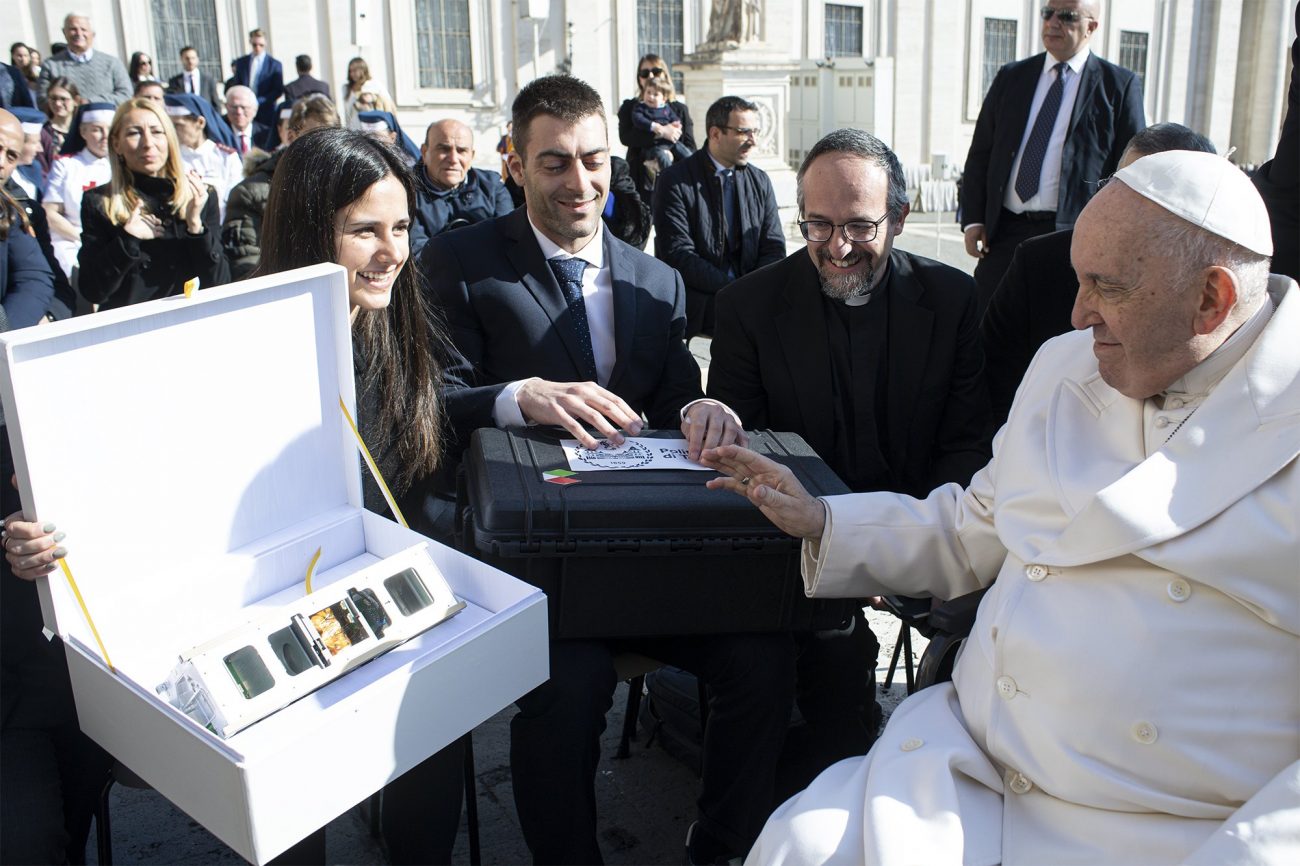VATICAN CITY (CNS) — Pope Francis’ message of hope for humanity encased in a small satellite blasted off into space June 12 and soon will beam his words back to Earth.
“The ‘Spei Satelles’ mission successfully launched from the U.S. base in Vandenberg, California, and in the coming days, it plans to deploy the CubeSat into orbit, carrying Pope Francis’ message of hope” contained in a nano version of the book, “Why Are You Afraid? Have You No Faith?” according to a press release June 13 from the Vatican Dicastery for Communication and agencies involved in the project.
Once deployed into orbit, the microsatellite was set to transmit papal messages of hope and peace in English, Italian and Spanish that any amateur radio receiver should be able to pick up. Its radio signals will be transmitted on the frequency of 437.5 MHz “with modulation GMSK at 9600 bit/s and protocol AX.25,” the press release said.
“At sunrise in different parts of the world, individuals will have the opportunity to receive words of comfort and encouragement along the paths of hope,” it said.
In addition to the papal nanobook, the “Spei Satelles” mission also carries a chip with the names and commitments of men, women and children on earth who requested a “boarding pass” to take part in the mission.
Since speisatelles.org was launched March 27, 2023, the press release said, “hundreds of individuals from all over the world have joined the project.”
By registering online, it said Catholics can symbolically “board” the mission by committing to carry out a corporal or spiritual work of mercy, and non-Catholics can perform a gesture or deed that fosters human fraternity.
“Given the success and the educational potential of membership, even though the launch has already taken place, it will still be possible to sign up, and names will be remotely written on the memory in orbit through the ground control station,” it added.
This way, the pope’s words will have symbolic significance “up there” in the heavens and concrete action “down here” on Earth, Father Luca Peyron, head of the Archdiocese of Turin’s apostolate for the digital world, said March 27.
The microsatellite was one of 72 CubeSats that took off from a SpaceX Falcon 9 rocket from Vandenberg Space Force Base in California June 12 with “microsatellites, hosted payloads and orbital transfer vehicles on the Transporter 8 rideshare mission” for customers from more than 18 countries, according to SpaceFlightNow.com.
The “Spei Satelles” space mission is promoted by the Dicastery for Communication and coordinated by the Italian Space Agency (ASI) and in collaboration with the Polytechnic University of Turin.
Researchers and students from the university’s department of mechanical and aerospace engineering built the CubeSat, which houses the nanobook created by Italy’s National Research Council (CNR). The lab converted the 150-page book — about 86 square feet of printed material — into binary code that fit on a tiny 2 mm-by-2 mm chip, which is about the size of the tip of a crayon.
The project was unveiled at the Vatican March 27, the anniversary of the prayer service which Pope Francis led in an empty St. Peter’s Square at the Vatican in the midst of the coronavirus pandemic in 2020. The pope’s words and images from that evening were shared worldwide first as a global livestream and then in the book.
Msgr. Lucio Adrián Ruiz, secretary of the Dicastery for Communication, said at a news conference unveiling the project, that the next step was to send the book literally around the world in a low Earth orbit satellite as a symbolic gesture of extending the pope’s loving embrace even farther.
The Latin name of the mission, “Spes Satelles,” can be translated as “satellite of hope” and “guardian of hope,” Msgr. Ruiz had said in March, to signify the satellite is also a guardian, keeping the pope’s message of hope alive for all of humanity.
The six-pound CubeSat, which will orbit approximately 326 miles (525 km) above the Earth’s surface, was blessed by Pope Francis during his general audience March 29.
In the June 13 press release, Msgr. Ruiz said that having Pope Francis’ message in space “serves as a sign and representation of tenderness and blessing for the world.”
“The vastness of space always sparks our imagination, and now we all need to dream together again, hoping that the much-awaited peace will return to the world by involving all of us,” he said.
PREVIOUS: Pope Doing Well After Abdominal Surgery, Asks for Continued Prayers
NEXT: UPDATE: Pope Continues Recovery Working, Resting, Praying




Share this story